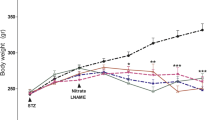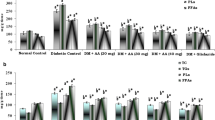Abstract
Succinic acid monoethyl ester (EMS) is recently proposed as an insulinotropic agent for the treatment of non-insulin dependent diabetes mellitus. Oxidative stress has been suggested to be a contributory factor in the development and complications of diabetes. In the present study the effect of EMS and Metformin on plasma glucose, insulin, serum and tissue lipid profile, lipoproteins and lipid peroxidation in streptozotocin–nicotinamide induced type 2 diabetic model was investigated. The carboxylic nutrient EMS was administered intraperitonially (8 µmol/g body weight) to streptozotocin diabetic rats for 30 days. The levels of thiobarbituric acid reactive substances (TBARS) and hydroperoxides in liver and kidney and serum and tissue lipids [cholesterol, triglycerides, phospholipids and free fatty acids] and very low density lipoprotein-cholesterol (VLDL-C) and low density lipoprotein-cholesterol (LDL-C), were significantly increased in diabetic rats, whereas the levels of high-density lipoprotein-cholesterol (HDL-C) and antiatherogenic index (AAI) (ratio of HDL to total cholesterol) were significantly decreased. The effect of EMS was compared with metformin, a reference drug. Treatment with EMS and metformin resulted in a significant reduction of plasma glucose with increase plasma insulin in diabetic rats. EMS also resulted in a significant decrease in serum and tissue lipids and lipid peroxidation products. These biochemical observations were supplemented by histopathological examination of liver and kidney section. Our results suggest the possible antihyperlipidemic and antiperoxidative effect of EMS apart from its antidiabetic effect.
Similar content being viewed by others
References
Baynes YW, Thorpe R (1999) Role of oxidative stress in diabetic complications. Diabetes 48:1–9
Robertson RP (2004) Chronic oxidative stress: a central mechanism for glucose toxicity in pancreatic islet beta cell in diabetes. J Biol Chem 279:42351–42354
Brown WV (1994). Lipoprotein disorders in diabetes mellitus. Med Clin N Am 78: 143–161
Betteridge J (1997) Lipid disorders in diabetes mellitus. In: Pickup JC, Williams G (eds) Text Book of Diabetes, Second ed. Blackwell Science, London, pp. 1–35
Wild S, Roglic G, Green A, Sicree R, King H (2004) Global prevalence of diabetes; Estimates for the year 2000 and projections for 2030. Diabetes Care 27:1047–1053
Sochar M, Baquer NZ, Mclean P (1985) Glucose under utilization in diabetes. Comparative studies on the changes in the activities of enzymes of glucose metabolism in rat kidney and liver. Mol Physiol 7:51–68
Morel DW, Chisolm GM (1989) Antioxidant treatment of diabetic rats inhibits lipoprotein oxidation and cytotoxicity. J Lipid Res 30:1827–1834
Seifter S, England S (1982) Energy metabolism. In: Arias I, Papper M, Schacter D, et al. (eds) The Liver; Biology and Pathology. New York, Reven Press, pp. 219–249
Picton SF, Flatt PR, Mcclenghan NH (2001) Differntial acute and long-term actions of succinic acid monomethyl ester exposure on insulin secreting BRAIN-BD 11 cells. Int J Exp Diabetes Res 2:19–27
Akkan AG, Malaisse WJ (1993) Protective effect of succinic acid monomethyl ester aginst streptozotocin induced diabete mellitus. Med Sci Res 214:467
Ishihara H, Wang H, Drewes LR, Wollheim CB (1999) Overexpression of monocarboxylate transporter and lactate dehydrogenase alters insulin secretory responses to pyruvate and lactate in beta cells. J Clin Invest 104:1621–1629
Ainscow E K, Zhao C, Rutter GA (2000) Acute over expression of lactate dehydrogenase-A perturbs beta-cell mitochondrial metabolism and insulin secretion. Diabetes 49:1149–1155
Alarcon C, Wicksteed B (2002) Succinate is a preferential metabolic stimulus-coupling signal for glucose-induced proinsulin biosynthesis translation. Diabetes 51:2496–2504
Zawalich WS, Zawalich KC (1992) Biochemical mechanisms involved in monomethyl succinate-induced insulin secretion. Endocrinology 131: 649–654
Ladriere L, Louchami K, Vinamber C, Kadiata MM, Jijakli H, Villanueva Penacarrillo ML, Valverde I, Malaisse WJ (1998) Insulinotropic action of the monoethyl ester of succinic acid. Gen Pharm 31: 377–383
Juan A, Martinez G, Maria L, Penacarrillo V, Valverde I, Bjorkling F, Malaisse WJ (1998) Potentiation of the insulinotropic and hypoglycemic action of gliquidone by succinic acid esters. Eur J Pharmacol 325:65–68
Uchigata Y, Yamamoto H, Nagai H, Okamoto H (1983) Effect of poly (ADP-ribose) synthetase inhibitor administration to rats before and after injection of alloxan and streptozotocin on islet proinsulin synthesis. Diabetes 32: 316–318
Masiello P, Broca C, Gross R, Roye M, Manteghetti M, Hillaire-Buys D, Novelli M, Ribes G (1998) Experimental NIDDM: development of a new model in adult rats administered streptozotocin and nicotinamide. Diabetes 47: 224–229
Novelli M, Fabregat ME, Fernandez-Alvarez J, Gomis R, Masiello P (2001) Metabolic and functional studies on isolated islets in a new rat model of type 2 diabetes. Mol Cell Endocrinol 175: 57–66
Reusch JE (1998) Focus on insulin resistance in type-2 diabetes: therapeutic implications. Diabetes Educ 24:188–193
Lebovitz HE (2001) Oral therapies for diabetic hyperglycemia. Endocrinol Metab Clin N 30:909–933
Bailey CJ, Turner RC (1996) Metformin. New Engl J Med 334: 574–579
Setter SM, Iltz JL, Thams J, Campbell RK (2003) Metformin hydrochloride in the treatment of type-2 diabetes mellitus: a clinical review with a focus on dual therapy. Clin Therap 25: 2991–3026
Pari L, Saravanan R (2005) Succinic acid monoethyl ester and metformin regulates carbohydrate metabolic enzymes and improves glycemic control in streptozotocin–nicotinamide induced type 2 diabetic rats. Iranian J Pharmacol Therapeut 4:132–135
Yanardag R, Ozsoy-Sacan O, Bolkent S, Orak H, Karabulut-Bulan O (2005) Protective effects of metformin treatment on the liver injury of streptozotocin-diabetic rats. Hum Exp Toxicol 24: 129–135
Trinder P (1969) Determination of glucose in blood using glucose oxidase with an alternative oxygen acceptor. Ann Clin Biochem 6:24–27
Niehius WG, Samuelsson D (1968) Formation of malondialdehyde from phospholipid arachidonate during microsomal lipid peroxidation. Eur J Biochem 6: 126–130
Jiang ZY, Hunt JV, Wolft SD (1992) Ferrous ion oxidation in the presence of xylenol orange for detection of lipid hydroperoxide in low density lipoprotein. Anal Biochem 202: 384–389
Folch J, Lees M, Solane SGH (1957) A simple method for isolation and purification of total lipids from animal tissues. J Biol Chem 226:497–509
Zlatkis A, Zak B, Boyle GJ (1953) A method for the determination of serum cholesterol. J Clin Med 41:486–492
Burnstein M, Scholnic MR, Mortin R (1970) Rapid method of isolation of lipoprotein from human serum by precipitation of polyanion. J Lipid Res 11: 583–587
Friedward WT, Levy R, Fradrickson DS (1972) Estimation of concentration of low-density lipoprotein cholesterol in plasma without the use of preparative ultracentrifuge. Clin Chem 19: 449–452
Guido S, Joseph T (1992) Effect of chemically different calcium antagonists on lipid profile in rats fed on a high fat diet. Indian J Exp Biol 30: 292–294
Foster JB, Dunn RT (1973) Stable reagents for determination of serum triglyceride by colorimetric condensation method. Clin Chim Acta 19:338–340
Zilversmit BB, Davis AK (1950) Micro determination of plasma phospholipids by TCA precipitation. J Lab Clin Med 35:155–160
Fiske CH, Subbarow J (1925) The colorimetric determination of Phosphorus. J Biol Chem 66: 375–400
Falholt K, Falholt W, Lund B (1973) An assay colorimetric method for routine determination of free fatty acids in plasma. Clin Chim Acta 46: 105–111
Philipp B, Shapiro DJ (1979) Improved methods for the assay and activation of 3-hydroxy-3-methylglutaryl-co-enzyme A reductase. J Lipid Res 20: 588–593
Duncan BD (1957) Multiple range test for correlated and heteroscedastic means. Biometrics 13:359–364
Gandhi HR (2001) Diabetes and coronary artery disease: importance of risk factors. Cardiol Today 1: 31–34
Grudy MS, Benjamin IJ, Burke GL, Chait A, Eckel RH, Howard BV (1999) Diabetes and cardiovascular disease. A statement for healthcare professionals from the American heart association. Circulation 100: 1134–1146
Al-Shamaony L, Al-Khazraji SM, Twaiji IA (1994) Hypoglycemic effect of Artemisia herba alba. II. Effect of a valuable extract on some blood parametes in diabetic animals. J Ethnopharmacol 43:167–171
Rajalingam R, Srinivasan N, Govindarajulu P (1993) Effect of alloxan-induced diabetes on lipid profiles in renal cortex and medulla of mature albino rats. Indian J Exp Biol 31: 577–579
Stone G, Van Thiel DH (1985) Diabetes mellitus, the liver. Seminar Liver 5: 8–28
Ashokkumar N, Pari L, Manimekalai A, Selvaraju K (2005) Effect of N-benzoyl-D-phenylalanine on streptozotocin induced changes in the lipids and lipoprotein profile in rats. J Pharm Pharmacol 57:359–366
Mendez JD, Balderas F (2001) Regulation of hyperglycemia and dyslipidemia by exogenous L-arginine in diabetic rats. Biochimie 83:453–458
Eddouks M, Lemhadri A, Michel JB (2005) Hypolipidemic activity of aqueousextract of Capparis spinosa L. in normal and diabetic rats. J Ethnopharmacol 98:345–350
Sharma SB, Nasir A, Prabhu KM, Murthy PS, Dev G (2003) Hypoglycaemic and hypolipidemic effect of ethanolic extract of seeds of Eugenia jambolana in alloxan-induced diabetic rabbits. J Ethnopharmacol 85:201–206
Slater HL, Packard CJ, Bicker S, Shephered J (1980) Effects of cholestyramine on receptor mediated plasma clearance and tissue uptake of human low dansity lipoprotein in the rabbit. J Biol Chem 255:10210–10213
Laakso M, Lehto S, Penttila I, Pyorala K (1993) Lipids and lipoproteins predicting coronary heart disease mortality and morbidity in patients with non-insulin-dependent diabetes mellitus. Circulation 88:1421–1430
National Cholesterol Education Program Expert Panel: Circulation 89: 1329, 1994
Kudchodkar BJ, Lee JC, Lee SM, DiMarco NM, Lacko AG (1988) Effect of dietary protein on cholesterol homeostasis in diabetic rats. J Lipid Res 29: 1272–1287
Bruan JEA, Severson DL (1992) Lipoprotein lipase release from cardiac myocytes is increased by decavandate but not insulin. Am J Physiol 262: E663–E670
Lopes-Virella MF, Whitmann HJ, Mayleld PK, Loadhott CB, Colwell JA (1983) Effect of metabolic control on lipid, lipoprotein and apolipoprotein levels in 55 insulin-dependent diabetic patients: a longitudinal study. Diabetes 32: 20–25
Bopanna KN, Kannan J, Sushma G, Balaraman R, Rathod SP (1997) Antidiabetic and antihyperlipidemic effect of neem seed, kernal powder on streptozotocin–nicotinamide diabetic rabbits. Indian J Pharmacol 29: 162–167
Dario G, Antonio C, Giuseppe P (1996) Oxidative stress and diabetic complications. Diabetes Care 19:257–267
Cohn RM, Roth KS (1996) Lipid and lipoprotein metabolism. Biochemistry and disease. Williams and Wilkins Publishers, Baltimore p. 280
Ahmed M, Shikha HA, Sadhu SK, Rahman MT, Datta BK (2001) Diuretic, and anti-inflammatory principle from Scoparia dulcis. Pharmazie 56: 657–660
Pari L, Ashokkumar N (2005) Effect of N-benzoyl-d-phenyalanine on lipid profile in liver of neonatal streptozotocin diabetic rats. Fund Clin Pharmacol 19:563–568
Mendez JD, Balderas FL (2006) Inhibition by L-arginine and spermidine of hemoglobin glycation and lipid peroxidation in rats with induced diabetes. Biomed Pharmacother 60: 26–31
Duarte AI, Santos MS, Seica R, Oliveira CR (2004) Oxidative stress affects synaptosomal gamma-aminobutyric acid and glutamate transport in diabetic rats: the role of insulin. Diabetes 53:2110–2116
Saravanan R, Pari L (2006) Succinic acid monoethyl ester prevents oxidative stress in sterptozotocin–nicotinamide induced type2 diabetic rats. J Basic Clin Physiol Pharmacol 17: 115–132
Mano T, Shinohara R, Nagasaka A, Nakagawa H, Uchimura K, Hayashi R, Nakano I, Tsugawa T, Watanabe F, Kobayashi T, Fujiwara K, Nakai A, Itoh M (2000) Scavenging effect of nicorandil on free radicals and lipid peroxide in streptozotocin-induced diabetic rats. Metabolism 49:427–431
Sato Y, Hotto N, Sakamoto N, Matsuoka S, Ohishi N, Yagi K (1979) Lipid peroxide level in plasma of diabetic patients. Biochem Med 21: 104–107
Hunt JV, Smith CCT, Wolff SP (1990) Autooxidative glycosylation and possible involvement of peroxides and free radicals in LDL modification by glucose. Diabetes 39: 1420–1424
Kwiatkowsha S, Piasecka G, Zieba M, Piotrowski W, Nowak D (1999) Increased serum concentrations of conjugated dienes and malondialdehyde in patients with pulmonary tuberculosis. Respiratory Med 93: 272–276
Author information
Authors and Affiliations
Corresponding author
Rights and permissions
About this article
Cite this article
Saravanan, R., Pari, L. Succinic acid monoethyl ester, a novel insulinotropic agent: Effect on lipid composition and lipid peroxidation in streptozotocin–nicotin-amide induced type 2 diabetic rats. Mol Cell Biochem 296, 165–176 (2007). https://doi.org/10.1007/s11010-006-9312-6
Received:
Accepted:
Published:
Issue Date:
DOI: https://doi.org/10.1007/s11010-006-9312-6




